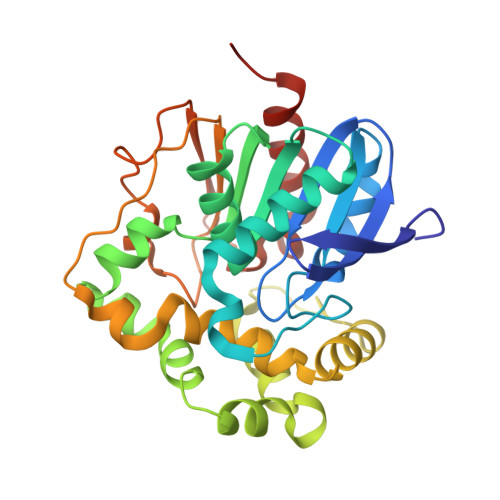New Thermophilic alpha / beta Class Epoxide Hydrolases Found in Metagenomes From Hot Environments.
Ferrandi, E.E., Sayer, C., De Rose, S.A., Guazzelli, E., Marchesi, C., Saneei, V., Isupov, M.N., Littlechild, J.A., Monti, D.(2018) Front Bioeng Biotechnol 6: 144-144
- PubMed: 30386778
- DOI: https://doi.org/10.3389/fbioe.2018.00144
- Primary Citation of Related Structures:
5NFQ, 5NG7 - PubMed Abstract:
Two novel epoxide hydrolases (EHs), Sibe-EH and CH65-EH, were identified in the metagenomes of samples collected in hot springs in Russia and China, respectively. The two α/β hydrolase superfamily fold enzymes were cloned, over-expressed in Escherichia coli , purified and characterized. The new EHs were active toward a broad range of substrates, and in particular, Sibe-EH was excellent in the desymmetrization of cis -2,3-epoxybutane producing the (2 R ,3 R )-diol product with ee exceeding 99%. Interestingly these enzymes also hydrolyse (4 R )-limonene-1,2-epoxide with Sibe-EH being specific for the trans isomer. The Sibe-EH is a monomer in solution whereas the CH65-EH is a dimer. Both enzymes showed high melting temperatures with the CH65-EH being the highest at 85°C retaining 80% of its initial activity after 3 h thermal treatment at 70°C making it the most thermal tolerant wild type epoxide hydrolase described. The Sibe-EH and CH65-EH have been crystallized and their structures determined to high resolution, 1.6 and 1.4 Å, respectively. The CH65-EH enzyme forms a dimer via its cap domains with different relative orientation of the monomers compared to previously described EHs. The entrance to the active site cavity is located in a different position in CH65-EH and Sibe-EH in relation to other known bacterial and mammalian EHs.
Organizational Affiliation:
Istituto di Chimica del Riconoscimento Molecolare, C.N.R., Milan, Italy.


















